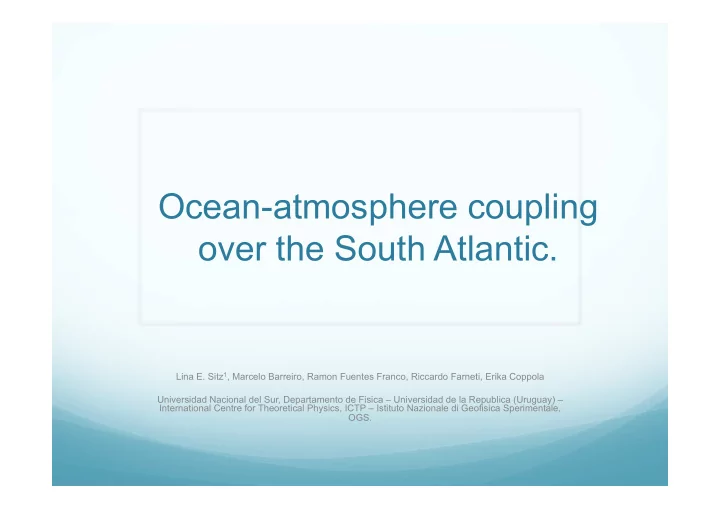

Ocean-atmosphere coupling over the South Atlantic. Lina E. Sitz 1 , Marcelo Barreiro, Ramon Fuentes Franco, Riccardo Farneti, Erika Coppola Universidad Nacional del Sur, Departamento de Fisica – Universidad de la Republica (Uruguay) – International Centre for Theoretical Physics, ICTP – Istituto Nazionale di Geofisica Sperimentale, OGS.
Motivation: The South Atlantic, why?
Motivation: The South Atlantic, why? Global heat transport The circulation in the South Atlantic is unique, in that it is the only major ocean basin that transports heat from the pole towards the Atlantic equator, a dynamic ocean process that is important to the global distribution of energy.
Thermohaline circulation Cold water enters the South Atlantic from the Pacific around the southern tip of South America. The Malvinas Current mets the warm poleward flowing Brazil Current in the B-M Confluence Zone. The Agulhas Current in the Indian Ocean flows down the southeast coast of Africa and past the tip of South Africa then takes a sharp turn to the east. Large eddies called Agulhas Rings spin off this bend and carry huge bundles of warm salty Indian Ocean water west into the South Atlantic.
The South Atlantic, not only physical processes In 2012, a global composite map of Earth’s night lights revealed human activity well offshore from South America. (NASA Earth Observatory/NOAA National Geophysical Data Center)
Air-sea interaction • The Atlantic ITCZ bias in CMIP5 models (Siongco et al 2014) • The Benguela Upwelling System: Quantifying the Sensitivity to Resolution and Coastal Wind Representation in a Global Climate Model (Small et al 2015) • Intraseasonal variability of tropical Atlantic sea-surface temperature: air–sea interaction over upwelling fronts (Diakhaté et al 2015) • Modulation mechanisms of marine atmospheric boundary layer at the Brazil-Malvinas Confluence region (Camargo et al 2013) • SST-Induced Surface Wind Variations over the Brazil–Malvinas Confluence: Satellite and In Situ Observations (Tokinaga et al 2005) • A study of the air-sea interaction in the South Atlantic Convergence Zone through Granger Causality (Tirabassi et. al 2014)
Model configuration Atmosphere • Version: RegCM 4.5 • Horizonal resolution: 50 km • Boundary conditions: Era-Interim. • Planetary Boundary Layer: UW/Hostlag • Ocean Fluxes: Zeng • Land surface: CLM4.5 • Convection: Emanuel / Tiedtke Ocean • Version: MITgcm 6.3 • Horizontal resolution: 0.125 deg • Vertical levels: 40 (dz from 10 to 250 m) • Boundary conditions: MOM ¼ deg. GCM. U, V, T, S fields. • Vertical mixing: Nonlocal K-Profile Parameterization (KPP, Large et al. 1990)
Observations vs Model DJF JJA
Extratropical air-sea interaction: the Brasil – Malvinas Confluence Cold water enters the South Atlantic from the Pacific around the southern tip of South America. The Malvinas Current mets the warm poleward flowing Brasil Current in the B-M Confluence Zone.
Extratropical air-sea interaction: the Brasil – Malvinas Confluence Wind div and SST Rainfall and SST Wind speed and SST CPL ATM The CPL model clearly shows air-sea coupling in the Brasil-Malvinas Confluence confirming the results of Tokinaga et al (2005): over the cold Malvinas currents winds are weaker, while they are strong over the warm Brasil current, generating a strong surface wind divergence at the front. This is consistent with the SST- induced vertical mixing mechanism for wind adjustment proposed in the literature. Moreover, rainfall is seen to increase substantially over the warm side of the front, with maxima over wind convergence.
Extratropical air sea interaction: the Aguhlas System The Agulhas Current in the Indian Ocean flows down the southeast coast of Africa and past the tip of South Africa then takes a sharp turn to the east. Large eddies called Agulhas Rings spin off this bend and carry huge bundles of warm salty Indian Ocean water west into the South Atlantic.
Extratropical air sea interaction: the Aguhlas System Rainfall and SST Wind div and SST Over the Agulhas current the CPL model shows a strong convergence of the surface winds surrounded by net divergence. As consequence there is increased rainfall over the warm Agulhas current and its retroflection.
Increasing resolution: Eddy Kinetic Energy OBS GCM CPL Increased resolution in the ocean component improves the location of the Brasil-Malvinas confluence and produces an overly energetic region. Coupling to the atmosphere reduces the EKE in the Brasil-Malvinas confluence, resulting in values closer to observed ones.
Choosing the best configuration EXP1 (Hostlag) EXP2 (UW) • The tropical SST bias is the result of atmosphere-ocean coupling and of deficient precipitation over tropical land masses (Richter et al 2012). • A realistic wind stress curl at the eastern boundary, and a high-resolution ocean model, are required to well simulate the Benguela upwelling system (Small et al. 2015).
SST bias: the ITCZ EXP1 (Hostlag) EXP2 (UW) UAS bias SW
Subtropical air-sea interaction: the SACZ EOF1 OBS 29% EOF1 ATM 19% Air sea interaction in the South Atlantic Convergence Zone is such that when the SACZ is weak, the SST below warms up due to increased solar radiation and decreased turbulent fluxes. The atmosphere- EOF1 EXP1 15% EOF1 EXP2 21% only model can not simulate this interaction and produces a stronger extension over the ocean due to local SST forcing.
Preliminary results and things to do... Frontal regions like those of the Brasil-Malvinas confluence and of the Agulhas current have been shown to induce a local forcing to the atmosphere. CPL reproduces this coupling on annual mean conditions. A configuration that represents better the precipitacion over the Amazon rainforest and the SACZ is needed. Selection of the convection scheme and evapotranspiration. Higher resolution is needed to improve the simulation of the upwelling Benguelas system
To be continued... Thanks! J
Recommend
More recommend